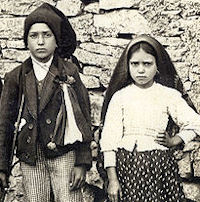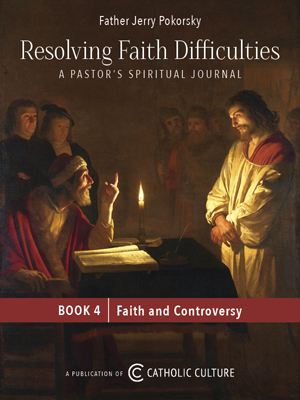Ordinary Time: February 20th
Friday of the Sixth Week of Ordinary Time
Other Commemorations: St. Jacinta Marto (RM)
» Enjoy our Liturgical Seasons series of e-books!
Then he questioned his father, "How long has this been happening to him"? He replied, "Since childhood. It has often thrown him into fire and into water to kill him. But if you can do anything, have compassion on us and help us." Jesus said to him, " 'If you can!' Everything is possible to one who has faith." Then the boy's father cried out, "I do believe, help my unbelief!" Jesus, on seeing a crowd rapidly gathering, rebuked the unclean spirit and said to it, "Mute and deaf spirit, I command you: come out of him and never enter him again" (Mark 9:21-26)!
Thanks to Fear of the Lord, There is no Fear of Evil
History, in fact, is not alone in the hands of dark powers, chance or human choices. Over the unleashing of evil energies, the vehement irruption of Satan, and the emergence of so many scourges and evils, the Lord rises, supreme arbiter of historical events. He leads history wisely towards the dawn of the new heavens and the new earth, sung in the final part of the book under the image of the new Jerusalem (cf. Revelation 21-22).
It must be reaffirmed that God is not indifferent to human events, but penetrates them realizing his "ways," i.e., his plans and his efficacious "deeds."
According to our hymn, this divine intervention has a very specific purpose: to be a sign that invites all the peoples of the earth to conversion. Nations must learn to "read" in history a message of God. Humanity's history is not confused and without meaning, nor is it given over, without appeal, to the malfeasance of the arrogant and perverse. There is the possibility to recognize divine action hidden in it. In the pastoral constitution "Gaudium et Spes," Vatican Council II also invites the believer to scrutinize, in the light of the Gospel, the signs of the times to see in them the manifestation of the very action of God (cf. n. 4 and 11). This attitude of faith leads man to recognize the power of God operating in history, and thus to open himself to fear of the name of the Lord. In biblical language, in fact, this "fear" does not coincide with dread, but is the recognition of the mystery of the divine transcendence. Because of this, it is the basis of faith and is joined with love: "the Lord your God requires of you, but to fear the Lord your God, to walk in all his ways, to love him, to serve the Lord your God with all your heart and with all your soul" (cf. Deuteronomy 10:12).
Following this line, in our brief hymn, taken from Revelation, fear and glorification of God are united: "Who will not fear you, Lord, or glorify your name" (15:4)? Thanks to fear of the Lord there is no fear of the evil that rages in history and one takes up again with vigor the journey of life, as the prophet Isaiah declared: "Strengthen the hands that are feeble, make firm the knees that are weak, say to those whose hearts are frightened: Be strong, fear not!'" (Isaiah 35: 3-4).
Excerpted from Thanks to Fear of the Lord, There Is No Fear of Evil, Pope Benedict XVI, May 11, 2005
St. Jacinta Marto
Between May 13 and October 13, 1917, three children, Portuguese shepherds from Aljustrel, received apparitions of Our Lady at Cova da Iria, near Fatima, a city 110 miles north of Lisbon. At that time, Europe was involved in an extremely bloody war. Portugal itself was in political turmoil, having overthrown its monarchy in 1910; the government disbanded religious organizations soon after.
At the first appearance, Mary asked the children to return to that spot on the thirteenth of each month for the next six months. She also asked them to learn to read and write and to pray the rosary “to obtain peace for the world and the end of the war.” They were to pray for sinners and for the conversion of Russia, which had recently overthrown Czar Nicholas II and was soon to fall under communism. Up to 90,000 people gathered for Mary’s final apparition on October 13, 1917.
Less than two years later, Francisco died of influenza in his family home. He was buried in the parish cemetery and then re-buried in the Fatima basilica in 1952. Jacinta died of influenza in Lisbon, offering her suffering for the conversion of sinners, peace in the world and the Holy Father. She was re-buried in the Fatima basilica in 1951. Their cousin, Lucia dos Santos, became a Carmelite nun and was still living when Jacinta and Francisco were beatified in 2000. Sister Lucia died five years later. The shrine of Our Lady of Fatima is visited by up to 20 million people a year.
—Excerpted from Saint of the Day: Lives, Lessons and Feast by Leonard Foley, O.F.M.; revised by Pat McCloskey, O.F.M.
Patronage: against bodily ills; captives; people ridiculed for their piety; prisoners; sick people; against sickness
Highlights and Things to Do:
- Learn more about St. Jacinta:
- Visit virtually the Shrine of Our Lady of Fatima in Fatima, Portugal.
- Read online Fatima in Lucia's Own Words.
- Catholic Cuisine for some food ideas for St. Jacinta.






